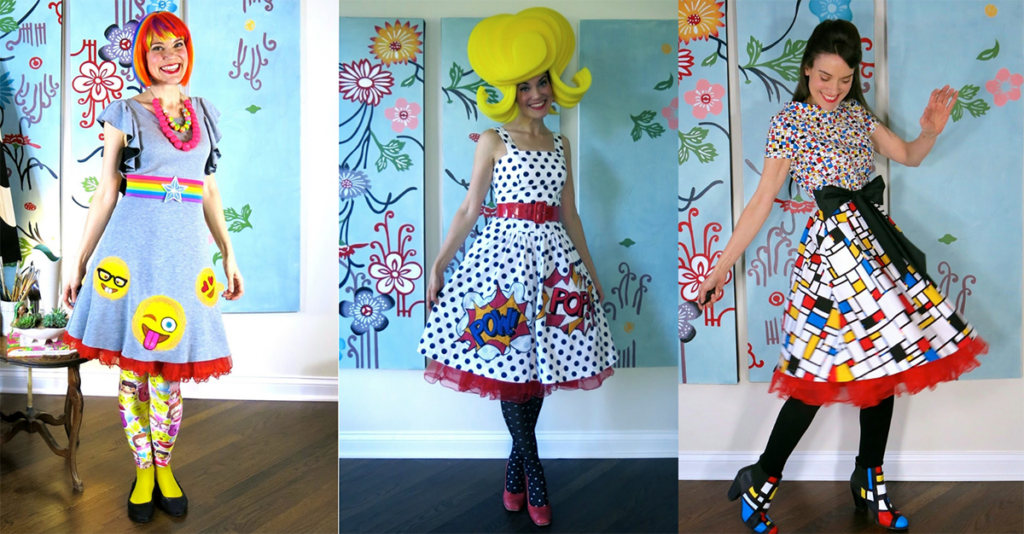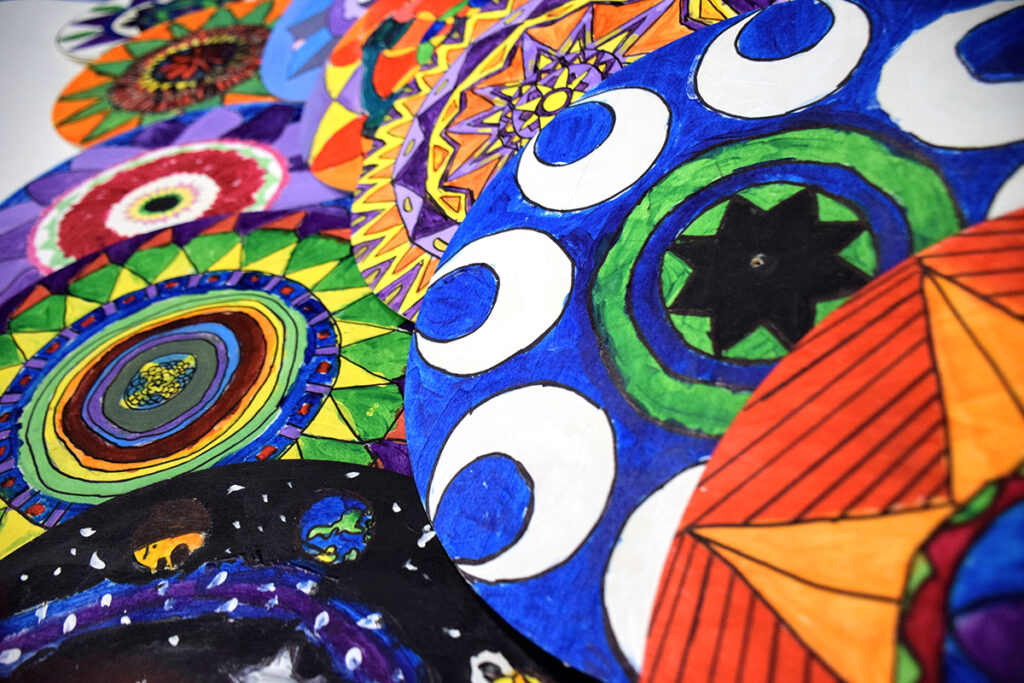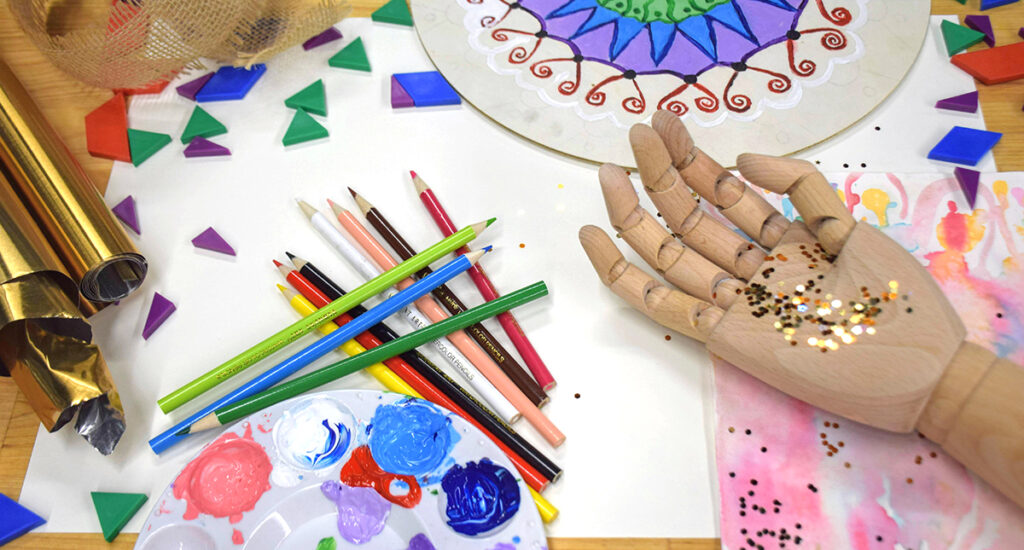Is Trying to Become a Art Teacher a Hard Major
Where does your teaching story begin?
I typically begin my instruction story with the pivotal moment in higher when I decided to apply to graduate school for art instruction. I wanted to practice something meaningful with my two art degrees. Upon deeper reflection, I realized it was manner back in fourth grade when my art instructor, Ms. Foley, saw me not just as a child or student but as an artist.

Wherever your teaching story began or how it unfolded, all teachers have one. It's always good to take a moment and retrieve where we started and why. On those tough days, information technology grounds us and reminds us why we are here.
Equally we close out the year, we want to remind you why existence an fine art instructor is still the all-time job always—even later on a pandemic!
1. We notice who students really are.
An art teacher'south superpower is the ability to speedily tune into a student'southward inner world through their art. We brand meaningful connections about their work, developmental stage, literacy, social-emotional state, and more. Yous can initiate early interventions when you observe students are in distress or are developmentally behind. You can back up them as they navigate their feelings. Some students find their anchor in your art form, which motivates them to work in their other classes.
ii. We tin can be arty.
Ms. Foley dazzled me. It was the mid-eighties, and she embraced the artist stereotype of that era. She had curt, platinum pilus (à la Madonna), wore oversized push-down shirts with a popped collar, statement jewelry in bold colors, and always smelled like minty chewing gum.
Anyone tin dress in whatever way they please, but artists seem to accept a special license to play with fashion. We have a artistic "pass" to experiment with pilus colour, jewelry, makeup, and shoes—or any your "thing" is. Through your own bold choices, you demonstrate creative risk-taking and embody your authenticity. And students dear that! Take Cassie Stephens, for instance. She leverages fashion to engage her students in learning. She explains, "I teach little kids, and I've always dressed a fiddling funky. I noticed that they really respond to that—and the sillier the better." Dressing artistically is fun and sends a message that you lot don't take yourself too seriously!

https://cassiestephens.blogspot.com/2014/10/diy-lichtenstein-apparel-thatll-knock-you.html https://cassiestephens.blogspot.com/2015/02/diy-mondrian-moment-in-dress-and-shoes.html
3. Our spaces are different.
Gliding through the studio, moving art from behemothic drying racks, Ms. Foley was a conductor—orchestrating projects and making magic happen. Like so many art rooms, information technology was this otherworldly space full of colour, excitement, strange tools, unlike rules, and the most unbelievably crawly pes pedal sink. No classroom in the school was as unique and exciting every bit the art room.
Art educator and architectural design consultant Marvin Bartel explains it the best, "An art room is a production facility… and an ideal fine art room has some attributes that are the opposite of those needed in [a] standard classroom." Art rooms are non similar other classrooms in the school, and they are not meant to be! The fact that art rooms part differently than other spaces ways that, like high-sounding dressing, art teachers can often be more playful with design and have risks with the organisation of their contents. Art teachers have leveled upward their rooms to be portals of creativity, from wall-to-wall murals to painted ceiling tiles and industrial effects to rainbow everything. Check some examples out hither, hither, and hither.

four. Nosotros can affirm students' behavior in themselves.
At the get-go of 4th grade, I begged Ms. Foley to let me to join her Footstep Art Lodge, a group of earnest, mitt-picked uncomplicated artists. Ms. Foley explained that Footstep Fine art was a commitment; that students participated in art contests and sometimes even traveled to art shows. She explained that I wasn't ready simply would consider me once more in 5th grade if I demonstrated my commitment during her regular class and managed the workload. At the end of 4th form, I felt such joy when Ms. Foley told me that I was "set" and could join the gild in fifth form!
Ms. Foley, and past extension all teachers, wield a powerful souvenir. Students need to be seen, heard, spoken with, and validated by the adults in their life. Teachers do merely that! My 4th-form fine art teacher probably had to filter many students from her club who were not set up to rising to the extracurricular commitments required. More importantly, Ms. Foley heard me out and gave me a hazard to evidence my power. She listened and didn't forget me. In supporting my goals, she helped grow my confidence and discover my insatiable drive to learn. The art room became a identify of condolement where I "fit in."
Art classes can provide an academic in-road for students who connect with their creativity. It gives students a class to look forward to. Studies bear witness that art instruction supports positive omnipresence, morale, and bookish accomplishment across the board.

5. Nosotros get to create and back up creation.
The deed of cosmos is magical. Fine art teachers put their special affect on everything from outfits and spaces to lessons and everyday objects. We spark marvel and generate wonder. In the words of Cassie Stephens, "You have to also exist creating in order to teach creating, and teach creatively."
From a tactile perspective, you get to offer students what they were largely missing during distance learning: hands-on access to materials such every bit paint (color) and clay (texture). Hands-on learning and fun materials tin ignite a sense of joy, innovation, and possibility. Kylie Rymanowicz reminds usa of the importance of creation. "Art is a natural activity to back up this gratuitous play in children. The liberty to manipulate different materials in an organic and unstructured mode allows for exploration and experimentation… Art allows youth to practice a wide range of skills that are useful not only for life but also for learning."

Art teachers and fine art classrooms accept students for who they are and what they create. Art students process their feelings, tell stories, make sense of political and social turmoil, and express their inner worlds through their work. We don't always have to understand each other's art or even like it. Still, nosotros know that anyone who shares their work is, past extension, sharing a piece of their identity. That takes a risk! You lot tin can maintain an inclusive climate, requite context to big feelings, and offer resource for ideas. You tin validate and accept students just as they are.
6. You can cultivate a Brave Space.
For many, the pandemic brought a lot of heavy stuff to the surface. The nature of the political climate, unrelenting news stories played on a loop, and topics like racism, gender identity, and mental health are just a few examples. You can model a "come as y'all are" attitude and set the expectation of being open-minded to foster a Rubber Space in your classroom. You can farther encourage students to take risks past talking through and creating art in response equally you nurture a Brave Infinite in your studio. Art teachers can demonstrate these values by embracing their vulnerability and making failure a positive learning experience.
The pandemic also weakened social skills because many were isolated at home. The art room is an ideal place to reintegrate and reinforce lost social skills. Your art tables can encourage students to communicate, share, and work equally a team later being stuck behind screens. Practicing collaboration and inclusivity and exploring identity helps unite students after about two unpredictable years of education, changing bodies, and a changing world.

While other educators may be pulled past the demands of testing, scores, and the threat of "learning loss," art teachers are called to create and inspire creation. Y'all have a unique role considering you get to know students through the art they produce. You can challenge students to grow and reach with your personal perspective and a hands-on arroyo. Your rooms (and outfits!) can reflect your creative license while besides being a Brave Infinite that supports vulnerability and the hard stuff life throws at u.s.. In the face of a challenging return to in-person learning, your job as an fine art instructor still stands out every bit the best job ever!
What is your favorite reason explaining why existence an fine art teacher is still the best?
What made you want to become an art teacher in the first place?
Magazine articles and podcasts are opinions of professional education contributors and do non necessarily represent the position of the Art of Education University (AOEU) or its bookish offerings. Contributors use terms in the way they are most often talked virtually in the scope of their educational experiences.
Source: https://theartofeducation.edu/2021/12/27/6-reasons-why-being-an-art-teacher-is-still-the-best-job-ever/